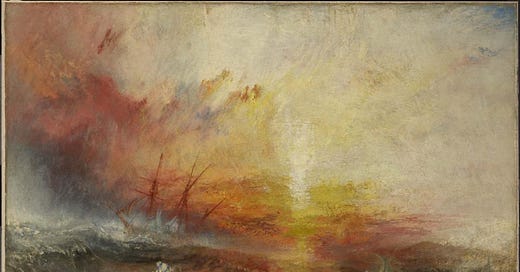J.M.W. Turner’s Slave Ship, Nature, and Having Eyes to See
Not so for many other painters of his era, among them the much celebrated members of the Hudson River School – whose works I, for one, have often sought out in museums. Beautiful many of their paintings are – mainly massive, often gorgeous, landscapes. But, may I say, against longstanding American celebrations of those grand works: such paintings often are not just luminescent, they also are illusory. That, for example, is how I read the great 1844 painting by the founder of the Hudson River School, Thomas Cole, “Frenchman’s Bay, Mount Desert Island, Maine.”
Executed about the same time as Turner’s Slave Ship painting, Frenchman’s Bay displays dramatic tidal surges running along steep and jagged rocky cliffs. But there are no signs of human anguish in this painting. Those tidal surges seem harmonious, too, almost as if the painting itself had been intended to be a still life. For Cole, nature appears to be first and foremost a pristine and dramatic, but self-contained world of its own. No suggestion of torn fishing nets here. Did Cole have eyes to see?
The painters of the Hudson River School, I believe, generally presupposed what I called in my first book, Brother Earth (1970), following the historian Perry Miller: the schizophrenia of the American mind. That fractured vision of reality shows us two worlds of experience, which were pitted against each other: Nature and Civilization. The first, whose chief representative I have taken to be Henry David Thoreau, was a world of pristine if agitated glory that was alleged to offer solace to broken or weary souls. The second, whose chief representative I have taken to be a later figure, Henry Ford, was a world of stark urban struggle, between the allegedly visionary lords of industry and the allegedly mindless masses of the poor. Faced with this kind of schizoid cultural choice between Nature and Civilization, numerous American painters, above all the Hudson River School, celebrated wilderness vistas. They announced, visually, that the nation could best find healing by a “return to nature.”
The point here is not that painters of the Hudson River School never depicted any kind of human presence in nature. They sometimes did. The point rather is that, in addition to everything else that their art highlighted, they consciously or unconsciously presupposed a consistent social agenda: to radically minimize human life in contrast to the grandeur of nature. In a word, they turned their backs on New York City and dramatized the vistas of that city’s major river upstream, as if the traumas of urban existence, poverty, slavery and its aftermath, and any kind of class struggle, did not exist. Nor were those painters much interested in what might be thought of as the positive values of urban life in that era, such as mutually supportive neighborhoods, religious associations, social clubs, and visions of a better life one day. The Hudson River School represented a movement of ideological escape at least as much as an aesthetic vision of natural glory. Its artists never really saw the torn fishing nets.
Thoughts like these pulsated in my mind early in 2022 when I joined many other New Englanders in making a pilgrimage to the Museum of Fine Arts in Boston to contemplate its stunning exhibit of dozens of paintings by Turner. Indeed, as I paused to contemplate numerous brilliant works by that great nineteenth century British artist, I knew where I was going – to contemplate one more time his vision of The Slave Ship.
Since that painting is owned by the MFA, I had seen it at different times, as an undergraduate and then as doctoral candidate in theology: and now as a retired octogenarian pastor and ecotheologian. Permit me then this perhaps odd-sounding observation, as one longstanding student of that work by Turner: every time I have stationed myself in front of that amazingly colored painting, this time being no exception, I have experienced existential dread, especially as one who has devoted so much of his life thinking about and encountering the world of nature.
How can one even think about a slave ship, never mind contemplate its agonies etched in the brilliant colors of its natural milieu? Once you have seen that painting by Turner, can you ever contemplate the majesties of nature again in the way that many members of the Hudson River School routinely did? Turner, I believe, surely had eyes to see. He showed us the overwhelming beauties and the wrenching tragedies of our world in one vision of a certain ship sailing away through those surging seas of color.
When I came home from the Turner exhibit, I kept asking myself: do I really have eyes to see? More particularly, do I have eyes to see the glories – and even at times, the agonies – of nature in a way that does not blind me to the excruciating realities of that Slave Ship?




